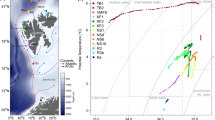Summary
The Antarctic copepod species Rhincalanus gigas, Calanoides acutus and Calanus propinquus were studied in the area of the Antarctic Peninsula in May 1986. Research was focussed on vertical distribution and stage composition of the populations. Rhincalanus gigas occurred in greatest densities in the upper layers of the water column, and copepodite stages CI and CII and nauplii dominated the population. Gut content analyses suggest that R. gigas was actively feeding. Copepodite stage CV dominated the Calanoides acutus population. At two deep basin stations (water depth>1000 m) the C. acutus population occurred below 500 m, whereas at shallower stations the majority was found above 300 m. Most specimens had empty guts. Calanus propinquus occurred in low densities, mainly in the upper water layers, and copepodite stage CV dominated. Most individuals of stage V had food in their guts. Our results suggest that C. acutus had ceased feeding and was overwintering in a resting stage (diapause), while C. propinquus and R. gigas were still active, the latter species having finished a late autumn spawning.
Similar content being viewed by others
References
Andrews KJH (1966) The distribution and life-history of Calanoides acutus (Giesbrecht). Discovery Rep 24:117–162
Atkinson A (1989) Distribution of six major copepod species around South Georgia during an austral winter. Polar Biol 10:81–88
Atkinson A (1991) Life cycles of Calanoides acutus, Calanus simillimus and Rhincalanus gigas (Copepoda: Calanoida) within the Scotia Sea. Mar Biol 109:79–91
Bradford JM (1971) The fauna of the Ross Sea, 8: Pelagic Copepoda. BullNZ Dep Sci In Res 206:9–31
Chojnacki J, Weglenska T (1984) Periodicity of composition, abundance, and vertical distribution of summer Zooplankton (1977/1978) in Ezcurra Inlet, Admiralty Bay (King George Island, South Shetland). J Plankton Res 6:997–1017
Hopkins TL (1971) Zooplankton standing crop in the Pacific sector of the Antarctic. In: Llano GA, Wallen TE (ededs) Antarctic Research Series 17, Biology of the Antarctic Seas IV, American Geographical Union, 347–362
Huntley M, Escritor F (1991) Dynamics of Calanoides acutus (Copepoda: Calanoida) in Antarctic coastal waters. Deep-Sea Res 38:1145–1167
Klöser H (1990) Verteilung von Mikroplankton-Organismen nordwestlich der Antarktischen Halbinsel unter dem Einfluß sich ädernder Umweltbedingungen im Herbst. Ber Polarforsch 77:255 pp
Marin V (1986) Distribution and life cycle of three Antarctic copepods (Calanoides acutus, Calanus propinquus, and Rhincalanus gigas). PhD thesis, University of California, San Diego, 177PP
Marin V (1987) The oceanographie structure of the eastern Scotia Sea-IV. Distribution of copepod species in relation to hydrography in 1981. Deep-Sea Res 34:105–121
Marin V (1988) Qualitative models of the life cycles of Calanoides acutus, Calanus propinquus and Rhincalanus gigas. Polar Biol 8:439–446
Ommaney FD (1936) Rhincalanus gigas (Brady) a copepod of the southern macroplankton. Discovery Rep 13:277–384
Ottestad P (1932) On the biology of some southern copepods. Hvalradets Skr 5:1–16
Ottestad P (1936) On Antarctic copepods from the “Norvegia” Expedition 1930–1931. Scientific Results of the Norwegian Antarctic Expeditions 1927–1928 et SQQ 15:1–44
Sahrhage D (1987) Summary and itinerary. In: Schnack-Schiel S (eded) The Winter-Expedition of RV “Polarstern” to the Antarctic (ANTV/1–3). Ber Polarforsch 39:14–17.
Schnack-Schiel SB, Hagen W, Mizdalski E (1991) A seasonal comparison of Calanoides acutus and Calanus propinquus (Copepoda: Calanoida) in the southeastern Weddell Sea, Antarctica. Mar Ecol Prog Ser 70:17–27
Stein M (1989) Seasonal variation of water masses in the Bransfield Strait and adjacent waters. Arch FischWiss 39:15–38
Vervoort W (1965) Notes on the biogeography and ecology of freeliving marine Copepoda. In: Oye Pv, Mieghem Jv (eds) Biogeography and Ecology of the Antarctic. Monogr Biol 15: Junk, The Hague, 381–401
Voronina NM (1970) Seasonal cycles of some common Antarctic copepod species. In: Holdgate MW (ed) Antarctic Ecology, Vol. 1, Academic Press, London & New York, 162–172
Voronina NM (1972) Vertical structure of a pelagic community in the Antarctic. Oceanology 12:415–420
Voronina NM (1978) Variability of ecosystems. In: Charnock H, Deacon G (eds) Advances in Oceanography, Plenum Press, New York, 221–243
Voronina NM, Vladimirskaya YeV, Zmiyevskaya MI (1978) Seasonal variations in the age composition and vertical distribution of common Zooplankton species in the Southern Ocean. Oceanology 18:335–338
Voronina NM, Menshutkin VV, Tseytlin VB (1980) Model investigations of the annual population cycle of the abundant copepod species Rhincalanus gigas and estimate of its production in the Antarctic. Oceanology 20:709–713
Author information
Authors and Affiliations
Rights and permissions
About this article
Cite this article
Marin, V.H., Schnack-Schiel, S.B. The occurrence of Rhincalanus gigas, Calanoides acutus, and Calanus propinquus (Copepoda: Calanoida) in late May in the area of the Antarctic Peninsula. Polar Biol 13, 35–40 (1993). https://doi.org/10.1007/BF00236581
Received:
Accepted:
Issue Date:
DOI: https://doi.org/10.1007/BF00236581



